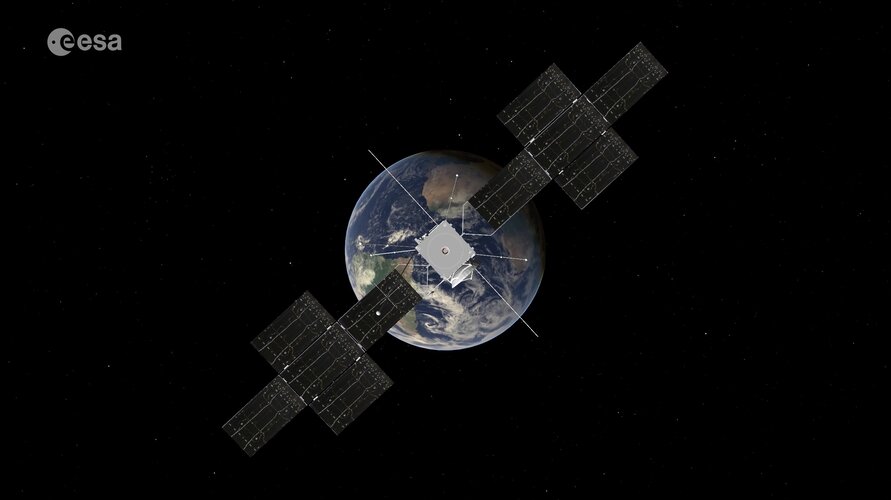Katie Wall, True Anomaly Director of Government Affairs — Leading Women in Space
Thursday, 26 September 2024 09:24

Japan launches IGS Radar 8 reconnaissance satellite with penultimate H-2A rocket
Thursday, 26 September 2024 08:27

Catalysing new space ventures with ESA’s Earth Observation Commercialisation Forum
Thursday, 26 September 2024 08:25
Taking place at KAP Europa in Frankfurt, Germany, from 27 to 28 November 2024, the second ESA Earth Observation Commercialisation Forum will bring together stakeholders from the Earth observation and space commercialisation sectors, including end users, space industry players, entrepreneurs, private and public investors and policymakers to discuss and promote commercial opportunities in Earth observation.
The event is an important part of ESA’s broader strategy to enhance the economic return from Earth observation investments to ensure that space technology contributes to sustainable economic growth.
Juice spacecraft forming wake in solar wind
Thursday, 26 September 2024 08:16
A spacecraft in flight cannot help but change the space about it – which can pose problems. A new paper in the Journal of Geophysical Research: Space Physics presents a study on how ESA’s Jupiter Icy Moons Explorer, Juice, is interacting with the solar wind. The consequences include potentially problematic surface charging, a dense cloud of photoelectrons that surround the spacecraft and a more than 65-m-long wake of ion-free space behind it, resembling the trail of a boat.
Leidos replaces Lockheed Martin on Artemis rover team
Wednesday, 25 September 2024 22:34

Iridium approved to work on LEO compatibility for upcoming smartphones
Wednesday, 25 September 2024 19:57

Robotic moving 'crew' preps for work on moon
Wednesday, 25 September 2024 19:20
As NASA moves forward with efforts to establish a long-term presence on the moon as part of the Artemis campaign, safely moving cargo from landers to the lunar surface is a crucial capability.
Whether the cargo, also known as payloads, are small scientific experiments or large technology to build infrastructure, there won't be a crew on the moon to do all the work, which is where robots and new software come in.
A team at NASA's Langley Research Center in Hampton, Virginia, spent the last couple of years infusing existing robotic hardware with a software system that makes the robot operate autonomously. Earlier this month, that team, led by researcher Dr. Julia Cline of NASA Langley's Research Directorate, ran demonstrations of their system called LANDO (Lightweight Surface Manipulation System AutoNomy capabilities Development for surface Operations and construction).
Record-breaking laser demonstration completes mission
Wednesday, 25 September 2024 18:48
NASA's TBIRD (TeraByte InfraRed Delivery) demonstration and its host spacecraft—the PTD-3 (Pathfinder Technology Demonstrator-3)—have completed their technology demonstration. The TBIRD payload spent the past two years breaking world records for the fastest satellite downlink from space using laser communications.
NASA's PTD series leverages a common commercial spacecraft to provide a robust platform for effective testing of technologies with minimal redesign in between launches. After launch in May 2022 on the SpaceX Transporter 5 mission, the PTD-3 spacecraft entered low-Earth orbit, and shortly after, TBIRD began sending laser communications signals to an optical ground station in Table Mountain, California.
TBIRD's two-year demonstration showcased the viability of laser communications. Most NASA missions rely on radio frequency communication systems. However, laser communications use infrared light and can pack significantly more data in a single communications link.
Space Force awards $25 million contract for satellite data integration
Wednesday, 25 September 2024 18:43

Space Force eyes commercial antennas to boost satellite control capacity
Wednesday, 25 September 2024 17:49
Is Starlink Good for Gaming? What Player Experiences Reveal About SpaceX's Satellite Internet
Wednesday, 25 September 2024 16:24 With the exponential growth in the gaming industry, internet speed has become a necessity. Many gamers live in rural areas where internet connectivity is challenged due to poor infrastructure.
This has barred them from engaging in online games. For such people, SpaceX's satellite internet, known as Starlink, promises to change this narrative. But the question remains: is Starlink good for
With the exponential growth in the gaming industry, internet speed has become a necessity. Many gamers live in rural areas where internet connectivity is challenged due to poor infrastructure.
This has barred them from engaging in online games. For such people, SpaceX's satellite internet, known as Starlink, promises to change this narrative. But the question remains: is Starlink good for All The Stars Align for a Record-Breaking Breaking 75th IAC
Wednesday, 25 September 2024 15:40






